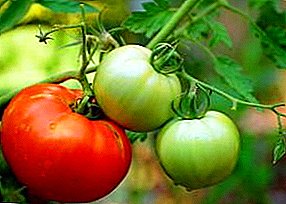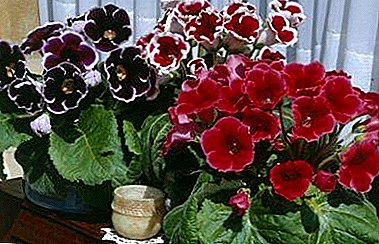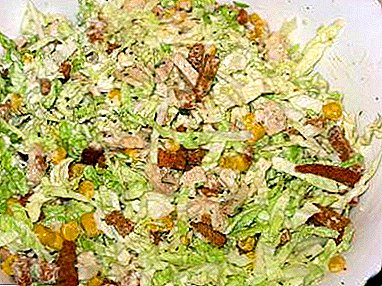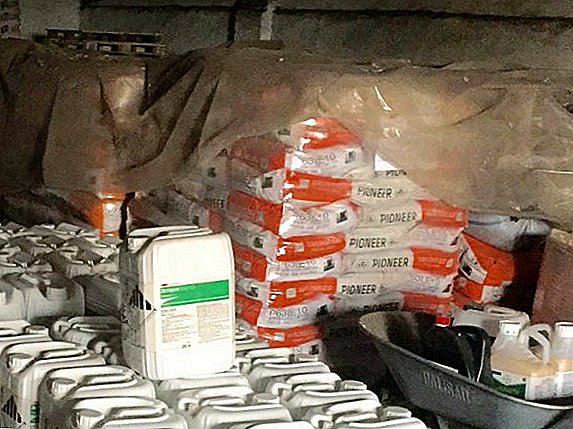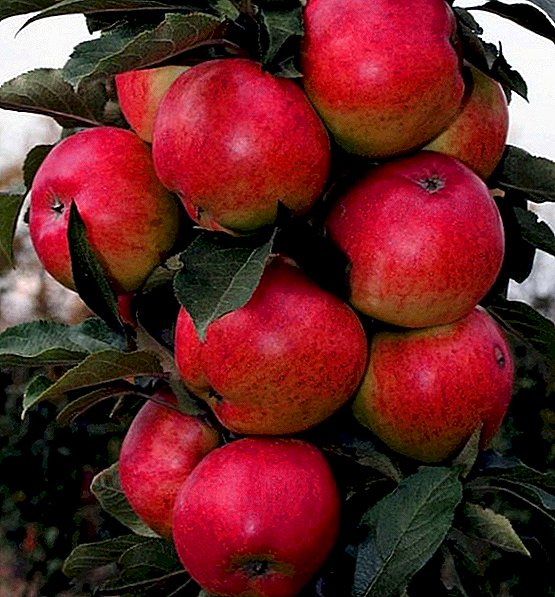
Arrangement of the greenhouse on the plot significantly expands the field of activity for gardeners. Due to the ability to capture and preserve the energy of solar radiation, the temperature of the air and soil in the greenhouse will be much higher than the street.
Therefore, it is possible not only to start gardening much earlier in spring, but also to prolong the harvest and fresh greens in autumn. In addition, if there is a solid foundation, a reliable frame and a heat source, such a greenhouse can be operated even in winter.
DIY greenhouse polycarbonate: advantages
 Traditional materials for creating a plot of closed ground include a variety of films and glass. but the films are of low strength, and the glass is heavy and prickly.
Traditional materials for creating a plot of closed ground include a variety of films and glass. but the films are of low strength, and the glass is heavy and prickly.
Therefore, in recent years, an increasing number of gardeners are inclined to using cellular polycarbonate to create such structures.
Inherent in polycarbonate such merits, as:
- high mechanical strength due to its design. Numerous stiffeners located inside the panel assume most of the load. Therefore, the greenhouse can be built without installing a particularly durable frame. You can use any available materials for the support frame - metal and plastic pipes, profiles, wooden beams, etc .;
- high thermal insulation qualityachieved by the air gap inside the panel;
- excellent light transmission, because through the plastic easily penetrates almost the entire spectrum of sunlight. This means the arrival of a large amount of energy inside the structure and an increase in its temperature;
- relatively low cost. Even taking into account the fact that the price of polycarbonate is higher than the price tag on the film, the operation of the greenhouse from this material is in fact much cheaper. This happens due to durability and the lack of need for continuous repair;
- self-assembly suitability. Due to the extreme simplicity of work with a very lightweight polycarbonate, to create a greenhouse out of it does not require any special skills and special tools. In addition, this feature eliminates the need for a gardener to use only greenhouses of standard sizes and shapes, as is the case with purchased models.
- homemade polycarbonate greenhouses can be modified at any time by the owner. Increase the size, make additional vents, repair or even replace the foundation - all this work can be carried out even if there are closed beds on the plants.
So, how to make (build) and correctly install a greenhouse made of polycarbonate on your plot (cottage) with your own hands, consider a phased work plan, diagrams, drawings and photos.
Optimal size
Three main factors influence the optimal (standard) dimensions of a polycarbonate greenhouse.
- Dimensions of the material.
- Plant height
- Convenience and efficiency of operation.
As a rule, there are on sale polycarbonate sheets 6 × 2.1 m. Based on these sizes, the optimal size of the greenhouse is calculated. So for the rectangular gable variant it will be convenient to cut the sheet across into four equal parts. Accordingly, the height of the side walls and the length of each slope will be 1.5 m.
The length of the greenhouse is the sum of the widths of each such element, equal to 2.1 m. On the garden plot is most reasonable to use greenhouses length either 4.2 or 6.3 m, those. arranged in two or three pieces of polycarbonate.
Shorter buildings constructed from just one sheet will be difficult to provide the necessary degree of strength. In the long can occur problems with additional heating in the cold season.
For arched greenhouses the most optimal sizes are 1.9 m high and 3.8 m wide. These are the dimensions that will be obtained if they ate a six-meter-wide polycarbonate sheet into the semicircle.
The resulting height of the structure will allow to grow plants of almost any size without any obstacles. At the same time the reserve of free space necessary for care of landings will be provided.
Putting beds inside the greenhouse is best along, having provided a distance from the walls of 15 cm. This will allow to place in the arched structure 3 beds 60 cm wide. Aisle width - 70 cm.

IMPORTANT
Change the ratio of the width of the beds and passes, if desired, can be. However, with very wide beds, caring for them can be problematic. Increasing the width of the aisles will lead to the loss of usable area.
Accommodation on the site
The most optimal place to install a greenhouse - open flat place on the fenced plot. The fence will save from gusts of wind, and the lack of shading will provide an adequate level of solar heat.

How to put a greenhouse of polycarbonate in the cardinal points? The ends of the facilities should look to the east and west.. With this orientation, the best lighting will be provided.

Creating a plot of closed ground, we should not forget about the usual open beds. For them, you need to leave a sufficient amount of unallocated space on the site. For more information about the rules for the location of greenhouses on the site can be read by following the link.
Preparation of the project and drawing
When building a greenhouse of cellular polycarbonate with your own hands, decide what size the greenhouse will have, then drawings and design should be made greenhouses (below are photos). The drawing should reflect the following elements:
- side and intermediate semi-arches;
- vertical racks;
- fastening elements to the foundation;
- horizontal stiffeners;
- small window;
- a door.

Besides, for each element in the drawing, specify the exact dimensions. This not only simplifies further work, but also allows you to more accurately determine the required amount of material.
The technology of building an arched greenhouse with a frame of polypropylene pipes
How to assemble (make) a greenhouse from polycarbonate itself, the instruction in which the manufacture and assembly of the hands, the drawing of the greenhouse with dimensions are described in stages, are discussed in this part of the article.
All work should be divided into several stages.
Stage 1. Foundation Construction
Since greenhouses made of polycarbonate are often of considerable size, under them recommended to build reliable foundations. If you plan to operate the greenhouse for more than one year, the ideal option would be to create shallow basement strip.
The procedure will be as follows:
- Outlines the perimeter of the structure.
- A trench is dug to a depth of 40 and a width of 25 cm.
- The timbering from boards or dense sheet material (DVP, a chipboard, plywood) is established.
- Sand cushion falls 5-10 cm thick.
- Reinforcement is laid either from metal wire or from plastic or steel mesh.
- Concrete is poured.
IMPORTANT
At the stage of building the foundation it stands Immediately lay the supporting elements for the frame fasteners. Most often for these purposes use metal corners or trim pipe. The distance between the supporting elements - 1 m.
Average time of hardening of the base - 5-7 days. Then you can proceed to further work.

Stage 2. Mounting frame
The frame of greenhouses under the polycarbonate is formed with his own hands as follows:
- PPR crosses are put on the support elements in the foundation, to which elements of the lower horizontal stiffener are soldered;
- Having completed the formation of the lower stiffener, elements of the semi-arches are soldered to the cross-pieces. The length of each element - 1 m;
- similar to the lower edge, an intermediate stiffening rib is formed;

- the middle elements bearing half-arcs are soldered and a second intermediate stiffener is created;
- in the upper part of the resulting frame, in the same way, a longitudinal ridge element is created from segments of plastic pipes and crosses;
- in the middle of the ends are driven in by two vertical posts. One pair of these racks will perform the functions of the door frame. Therefore, the distance between these racks should be 80 cm;
- set end horizontal stiffeners.
IMPORTANT
Soldering method polypropylene pipes allows to achieve maximum strength of the frame for the greenhouse. However, in the absence of electricity on the site or, if necessary, to have a collapsible design, use assembly on self-tapping screws or using clamps.
In addition to PPR pipes, the framework can be made on the basis of a profile metal pipe, a galvanized profile or a wooden bar. Option with metal profile tube gives the carcass design maximum strength. However, since it is impossible to bend a pipe made of metal, all the straight elements of the framework have to be placed at an angle to each other.
As a result, polycarbonate on such a frame has to be fixed only to a point and the plastic panel in places of fastening quickly collapses.
Galvanized profile convenient opportunity fasteners for screws. But due to the extremely low resistance to corrosion, such polycarbonate greenhouse structures, assembled by themselves, rarely last more than one or two seasons operation.
Wooden frameit is easy to install and durable enough, but like a galvanized profile, a tree in the atmosphere of a greenhouse will not last long. Somewhat increase the durability of the wooden frame by processing it with special waterproofing impregnations.
Stage 3. Fastening polycarbonate panels
Exists two main ways of mounting polycarbonate panels: dry and wet. In the latter case, the sheets are simply glued to the base. However, in relation to arched greenhouses with a frame made of polypropylene pipes, most often use the dry method, i.e. fasteners with screws and washers.
Fig. Fastening polycarbonate to the metal frame
To prevent the screw from damaging the plastic panel, a hole is pre-made in the right places in it. This can be done with an ordinary drill. The minimum distance to the edge of the web is 36 mm. You can drill only between stiffeners in polycarbonate panels.
IMPORTANT
The diameter of the holes to be drilled should be 2-3 mm higher than the diameter of the mounting screws. Otherwise, during thermal expansion, the material may be damaged by the thread of the screw.
The distance between fasteners depends on the thickness of the polycarbonate. So, for sheets 8-10 mm thickmost commonly used for greenhouses, fasteners must be 40-50 cm apart. For thicker samples, the distance can be increased to 60-80 cm.
In addition to the actual screws, part of the fastener includes a thermal washer with a lid. Their purpose is to maintain close contact of the polycarbonate with the frame, even during thermal expansion. Hard fastening without thermal washers will lead to rapid destruction of the material..
Between themselves, polycarbonate sheets are connected by one-piece or detachable profiles. These profiles allow you to seal the joints between the panelsas well as keep them stationary relative to each other.
Fig. Polycarbonate profiles
End profiles are used to seal the ends. In their absence, the edges of the polycarbonate sheets can be sealed with silicone sealant. If this is not done, water will penetrate into the cavities of the polycarbonate and may cause its damage.
Alternative designs
In addition to arches, other types of greenhouses can be collected on the basis of cellular polycarbonate.
1. Rectangular polycarbonate greenhouse with your own hands
The shape of the greenhouse in the form of a regular rectangle is selected only for small structures. With their help, you can insulate one separate bed in the spring season. To increase the size of the greenhouse of this form is undesirable, because polycarbonate greenhouse flat roof cannot withstand accumulated snow. In addition, rectangular greenhouses resist wind gusts.
2. Self-made polycarbonate greenhouse with your own hands
Such a structure is almost the same as a flat roof construction. The difference is only in the height of the walls. The back wall is made significantly higher than the front.
Tiltable greenhouses are conveniently placed in the immediate vicinity of the southern wall of the house. In this case, the slope of the roof will be optimal for obtaining the maximum solar energy.
3. Gable greenhouse
It is reasonable to use a gable roof for a greenhouse made of polycarbonate, which is built by hand, in cases where the plants will require a maximum of free space. This design will allow to arrange straight walls, increasing the internal volume (in comparison with the arch).
The disadvantage of such a structure is a more complex structure that requires the creation of a truss system.
4. Team Greenhouse
The prefabricated version of the greenhouse is convenient because in the hot months it is possible to remove it altogether from the site, thereby freeing up space. In addition, dThere is no need to create solid foundations for prefabricated greenhousesto keep land use up.
Installation of such greenhouses should not include welding work, all fasteners must be carried out on threaded connections or on clamps.
How to make a window, a window and a door
Any greenhouse must have an efficient ventilation system.. This will reduce the humidity level and regulate the temperature. Polycarbonate greenhouse premises are ventilated through windows and vents.
To equip the window or window, in the frame of the greenhouse it is necessary to provide appropriate places. The windows are most often placed on vertical walls, and the windows are located above the entrance door in the end..
To create a window box, the same construction materials are used as for the whole greenhouse frame. The easiest way is to arrange a window by cutting two additional horizontal frame ties between the vertical supports.

Structurally, the greenhouse door, window and window leaf can differ only in size. The easiest way to make them from the remnants of polycarbonate, securing the material on a light frame and providing it with light loops. If necessary, the door can be performed in a more serious version by installing a full-fledged wooden doorframe.
Conclusion
Cellular polycarbonate gives a wide field for the construction of greenhouses of various types. A small mass of such structures is successfully combined with good thermal insulation and ease of construction. Any home master will be able to build such a greenhouse, even without assistants and with the most modest budget.


